SEAT Ibiza
The SEAT Ibiza is a supermini car manufactured by Spanish car manufacturer SEAT since 1984. It is SEAT's best-selling car.[2] The Ibiza is named after the Spanish island of Ibiza, and it is the second SEAT model to be named after a Spanish city, after the SEAT Ronda. It was introduced at the 1984 Paris Motor Show as the first car developed by SEAT as an independent company, though it was designed by SEAT in collaboration with well-known firms such as Italdesign, Karmann and Porsche.[2]
| SEAT Ibiza | |
|---|---|
 | |
| Overview | |
| Manufacturer | SEAT |
| Production | 1984–present[1] |
| Body and chassis | |
| Class | Supermini (B) |
| Layout | Front-engine, front-wheel-drive |
| Chronology | |
| Predecessor | SEAT Fura |
From the second generation version onwards, SEAT formed part of the German automotive industry concern Volkswagen Group, and all further Ibiza generations, as well as the rest of the SEAT model range, were built on Volkswagen Group platforms, parts and technologies.
The Ibiza spans five generations, among which it has debuted twice (in its second and in its fourth generations) a new platform of the Volkswagen Group. All of them were the top seller model in SEAT's range.
The Ibiza is now available only in the five-door hatchback variants, and between 1993 and 2008, saloon, coupé and estate versions were sold as the SEAT Córdoba. In 2010, an estate version, called Ibiza ST, was launched.
First generation (021A; 1984)
| SEAT Ibiza Mk1 (021A) | |
|---|---|
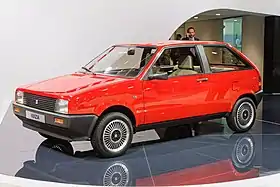 SEAT Ibiza Mk1 (pre-facelift) | |
| Overview | |
| Production | 1984–1993 1999–2008 (China) |
| Assembly | Spain: Barcelona |
| Designer | Giorgetto Giugiaro at Italdesign |
| Body and chassis | |
| Body style | 3 and 5-door hatchback |
| Related | Fiat Ritmo SEAT Ronda SEAT Málaga Nanjing Yuejin Soyat |
| Powertrain | |
| Engine | |
| Dimensions | |
| Wheelbase | 2,443 mm (96.2 in) |
| Length | 3,683 mm (145.0 in) |
| Width | 1,610 mm (63.4 in) |
| Height | 1,395 mm (54.9 in) |
.jpg.webp)
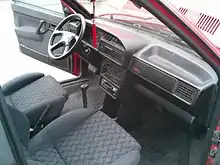
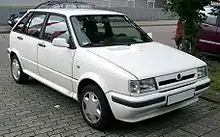
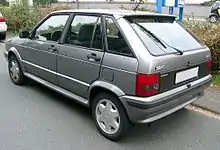
Introduced in the 1984 Paris Motor Show, the SEAT Ibiza Mk1 (codenamed 021A) entered production in the 'Zona Franca' assembly lines on 27 April 1984[3] and proved to be a success for the Spanish manufacturer, as it sold 1,342,001 units until the launch of its second generation in 1993.[2] The Ibiza's sales success gave the SEAT marque a platform to build on, as it looked to increase sales in following years.
This version, while it established the now classic Ibiza shape, was advertised as having "Italian styling and German engines": having its bodywork been designed by Giorgetto Giugiaro's Italdesign,[4] and being prepared for industrialisation by the German manufacturer Karmann.[3] It was based on the SEAT Ronda, a small family car, which in turn was based on the Fiat Ritmo. The gearbox and powertrain were developed in collaboration with Porsche, thus named under licence System Porsche. Despite Porsche's direct involvement in the Ibiza's engines, it was only after paying a royalty of 7 German marks per car sold back to Porsche that SEAT gained the right to put the 'System Porsche' inscription on the engine blocks.[5]
By the time Giugiaro was assigned to the Ibiza project, his previous proposal for the second generation of the Volkswagen Golf had been rejected by Volkswagen. So when SEAT approached him with the proposal for a spacious supermini class contender, that particular project was reincarnated as the first generation of the SEAT Ibiza.[6]
Using a compact car as basis, in terms of size, it was larger than most superminis like the Ford Fiesta and Opel Corsa/Vauxhall Nova, but smaller than any small family car such as the Ford Escort and Opel Kadett/Vauxhall Astra. The luggage capacity started from 320 litres and increased to 1,200 litres after folding rear seats.
It was launched on the United Kingdom market in September 1985, when the brand was launched there, along with the Malaga saloon. It largely competed with budget offerings like the Hyundai Pony, and gave budget buyers a more modern alternative to the outdated offerings from Lada, Škoda, Yugo and FSO. After a slow start, sales picked up and reached the 10,000-a-year milestone by the end of the decade.
The interior space was good but styling was fairly unimaginative even though it was known for having a rather quirky interior instrument layout, marked by a lack of control stalks. The indicators were operated by a rocker-switch, and the headlights by a sliding switch. It had three principal trim levels (L, GL and GLX) with bodyworks of 3 and 5 doors and several versions such as Base, Special, Disco, Chrono, Designer, Fashion, SXi etc.[6] As power outputs dropped due to more stringent emissions requirements, a 1.7-litre version of the engine was developed for the Sportline version. For the same reason, a 109 PS (80 kW) turbocharged version of the 1.5-litre engine was developed for the Swiss market and presented in March 1989.[7]
In the meantime, SEAT had already signed a cooperation agreement with Volkswagen (1982) and in 1986 the German car maker became SEAT's major shareholder. The Ibiza Mark 1 received a very light restyling in early 1989 with a moderate facelift in the exterior, an entirely new, less radical interior, and many mechanical modifications.[8] This is referred to as the second series, although it can be hard to distinguish from the original. Most obvious is the shift from a black plastic grille with seven bars to one with four body-colored ones, with some models receiving new side moldings. The interior was all new, with new seats and a new steering wheel, while the gearbox was thoroughly redesigned, and the brakes and steering improved.[9] At the time, the Ibiza was being produced at a rate of 1100 cars per day, and the cumulative production had reached a half million.[8]
A more thorough restyling was launched in 1991 under the name New style, although by now an all-new Ibiza was being developed.
The following year, in February 1992, SEAT launched the Ibiza "Serie Olímpica" to celebrate SEAT's participation in the 1992 Olympic Games in Barcelona as a sponsor, and the SEAT Ibiza Mk1 along with the SEAT Toledo Mk1 became the official cars of the Games. The larger sedan version SEAT Málaga was a closer relative to the SEAT Ronda, although it shared engines with the Ibiza.
Engine specifications

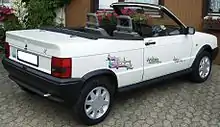
All engines were inline-four-cylinder units, front transverse mounted:[10] The 0.9-litre and 1.2-litre engines had carburetor, as did the 1.5-litre 85 hp engine, while the 1.5-litre 90 hp and 1.7-litre engines, introduced in 1989, used single-point injection systems. The 1.5-litre 100 hp, introduced in 1988, had multi-point fuel injection. The 1.7-litre diesel was an indirect injection unit.[11]
| Type | Engine code | Make | Displacement | Fuel type | Catalysator | Max. power | Max. torque | Bore x stroke | Indicated maximum speed |
|---|---|---|---|---|---|---|---|---|---|
| Gas engines | |||||||||
| 0.9 8V | 146A.000 | Fiat | 903 cm³ | carburetor (WEBER 32 ICEV)[12] | since 1989 | 46 PS (34 kW; 45 hp) | 56 N⋅m (41 lb⋅ft) | 65,0 x 68,0 mm | 130 km/h (81 mph) |
| 1.2 8V | 021A1.000 | Seat + Porsche | 1,193 cm³ | carburetor (Pierburg 1 B 3) | no | 63 PS (46 kW; 62 hp) | 86 N⋅m (63 lb⋅ft) | 75,0 x 67,5 mm | 155 km/h (96 mp/h) |
| 021C1.000 | Seat + Porsche | injection (BOSCH LU2 - Jetronic) | yes | 71 PS (52 kW; 70 hp) | 96 N⋅m (71 lb⋅ft) | 157 km/h (97 mp/h) | |||
| 1.5 8V | 021A2.000 | Seat + Porsche | 1,461 cm³ | carburetor (Bressel-Weber 32 DSTA 151) | no | 86 PS (63 kW; 85 hp) | 116 N⋅m (86 lb⋅ft) | 83,0 x 67,5 mm | 175 km/h (108 mp/h) |
| 021C2.000 | injection (BOSCH LU2 - Jetronic) | yes | 90 PS (66 kW; 89 hp) | 120 N⋅m (89 lb⋅ft) | |||||
| 021B2.000 | injection (BOSCH LE2 - Jetronic) | no | 100 PS (74 kW; 99 hp) | 128 N⋅m (94 lb⋅ft) | 184 km/h (114 mp/h) | ||||
| 1.5 8V Turbo | – | Seat + Porsche | 1,461 cm³ | – | – | 109 PS (80 kW; 108 hp) | – | 83,0 x 67,5 mm | – |
| 1.7 8V | 021A3.000 | Seat + Porsche | 1,675 cm³ | injection (BOSCH LU2 - Jetronic) | – | 98 PS (72 kW; 97 hp) | – | 83,0 x 77,4 mm | – |
| 021B3.000 | yes | 100 PS (74 kW; 99 hp) | 138 N⋅m (102 lb⋅ft) | 182 km/h (113 mp/h) | |||||
| 021C3.000 | – | 108 PS (79 kW; 107 hp) | – | – | |||||
| Diesel engines | |||||||||
| 1.7 D | 022A5.000 | Fiat | 1,714 cm³ | injection (BOSCH CZ-B.494 263)[13] | no | 56 PS (41 kW; 55 hp) | 98 N⋅m (72 lb⋅ft) | 83,0 x 79,2 mm | 150 km/h (93 mp/h) |
| 138A5.000 | |||||||||
.jpg.webp)
Motorsport
The SEAT Ibiza Mk1 took part in several rally events and formed the basis on which the Campeonato SEAT Ibiza de Rallies was organised by the SEAT Sport division in 1985,[14] however its most notable rally version has been the all-wheel drive Ibiza Bimotor, manufactured in 1986 and equipped with two engines each one delivering power to the front and rear axle respectively.[15]
Rebadges
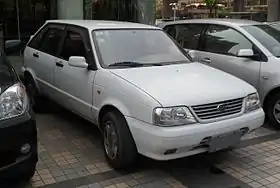
In 1997, the Ibiza Mk1 design license was bought by a joint venture between Chinese automaker Nanjing Automobile Group and Malaysia's Lion Group. It entered production in June 1999, as the Eagle, and was redeveloped and rebadged into the Nanjing Yuejin Soyat in late 2003.[16] Chinese Ibiza production came to a final end in 2008, after another facelift in 2007.
Derivatives
The Spanish company Emelba produced two derivatives of the SEAT Ibiza Mk1: the pickup derivative of the Ibiza, and the Emelba Siete, a 7-seat MPV derivative.
Other than the Emelba variants, further Ibiza Mk1 derivative models have been produced from several companies, like the Anibal Raider and Podadera models.[17]
Concept cars
SEAT has also produced on its own a cabriolet version of the SEAT Ibiza Mk1, named Ibiza cabrio, a model which is currently found in its Nave A122 site.[18]
Second generation (6K; 1993)
| SEAT Ibiza Mk2 (6K) | |
|---|---|
_front.jpg.webp) 1996–1999 SEAT Ibiza Mk2 facelift | |
| Overview | |
| Also called | Volkswagen Polo Playa (South Africa) |
| Production | 1993–2002 |
| Assembly | |
| Designer | Giorgetto Giugiaro at Italdesign |
| Body and chassis | |
| Body style | 3 and 5-door hatchback |
| Platform | Volkswagen Group A03 |
| Related | SEAT Córdoba Mk1 SEAT Inca Volkswagen Polo Mk3 Volkswagen Caddy |
| Powertrain | |
| Engine | Petrol engines: 1.0 L I4 8v 1.0 L I4 16v 1.05 L I4 1.3 L I4 1.4 L I4 8v 1.4 L I4 16v 1.6 L I4 1.8 L I4 8v 1.8 L I4 16v 1.8 L I4 20v Turbo 2.0 L I4 8v 2.0 L I4 16v Diesel engines: 1.9 L I4 D/SDI 1.9 L I4 TD/TDI |
| Dimensions | |
| Wheelbase | 2,443 mm (96.2 in) |
| Length | 3,853 mm (151.7 in) |
| Width | 1,640 mm (64.6 in) |
| Height | 1,422 mm (56.0 in) |
_rear.jpg.webp)
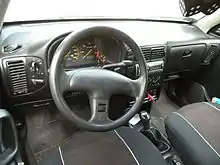
The Ibiza Mk2 (Typ 6K) was the first Ibiza generation fully developed and produced under the Volkswagen Group ownership. It was based on the modified platform of MK3 Golf.
This Ibiza was available in three and five-door models, the saloon/coupé variant was known as the SEAT Córdoba, and the estate was known as the SEAT Córdoba Vario. The Ibiza was regularly the best selling car in Spain and sold relatively well in the rest of Europe, helping SEAT increase its sales figures significantly from 1993 onwards.
In the interior, the pre-facelift Ibiza 6K shared the same dashboard with many other models from SEAT and Volkswagen, such as the SEAT Córdoba Mk1, the Volkswagen Polo Classic, the SEAT Inca, the Volkswagen Polo Mk3 etc.
Before facelift, the trim levels were i, CL, CLX, GLX, Pasion, S and GTI.
1996 revision
The 6K Ibiza had a minor facelift in 1996, which included changing the general aesthetics of the car, by adding smoother bumpers and changing the grille and headlamps and the trim levels offered (Base, E, S, SE, SXE, Sport, GT, GTI, GTI 16V, Cupra and Sport).
Other than changing the appearance of the car, the powertrain and running gear changed, with the addition of the 110 kW (150 PS; 148 bhp) 2.0 16v ABF petrol engine, the demise of the 1.8-litre 16v and the 2.0-litre 16v engines, previously in the Volkswagen Golf Mk3.
Engine specifications
| Model | Displacement | Valves | Max. power / rpm | Max. torque / rpm | Engine code | Production period |
|---|---|---|---|---|---|---|
| Petrol engines | ||||||
| 1.0 MPI | 999 cc | 8 | 50 PS (37 kW; 49 hp) / 5000 | 86 N⋅m (63 lb⋅ft) / 3000–3600 | AER | 1996–1999 |
| 1.05 i | 1,043 cc | 8 | 45 PS (33 kW; 44 hp) / 5200 | 76 N⋅m (56 lb⋅ft) / 2800 | AAU | 1993–1996 |
| 1.3 i | 1,272 cc | 8 | 54 PS (40 kW; 53 hp) / 5000 | 95 N⋅m (70 lb⋅ft) / 3200–3400 | AAV | 1993–1994 |
| 1.4 "Special" engine D, AR | 1,390 cc | 8 | 54 PS (40 kW; 53 hp)) / ? | ? Nm / ?–? | ANX | 1998–1999 |
| 1.4 i | 1,391 cc | 8 | 60 PS (44 kW; 59 hp) / 5200 | 107 N⋅m (79 lb⋅ft) / 2400–2800 | ABD | 1994–1996 |
| 1.4 MPI | 1,390 cc | 8 | 60 PS (44 kW; 59 hp) / 4700 | 116 N⋅m (86 lb⋅ft) / 2800–3200 | AEX / APQ | 1996–1999 |
| 1.4 MPI GT | 1,390 cc | 16 | 101 PS (74 kW; 100 hp) / 6000 | 128 N⋅m (94 lb⋅ft) / 4400 | AFH | 1996–1999 |
| 1.6 i | 1,598 cc | 8 | 75 PS (55 kW; 74 hp) / 5200 | 126 N⋅m (93 lb⋅ft) / 3400 | ABU | 1993–1994 |
| 1.6 i | 1,595 cc | 8 | 75 PS (55 kW; 74 hp) / 5200 | 125 N⋅m (92 lb⋅ft) / 2600 | 1F | 1994–1997 |
| 1.6 MPI | 1,598 cc | 8 | 75 PS (55 kW; 74 hp) / 4800 | 135 N⋅m (100 lbf⋅ft) / 2800–3600 | AEE | 1997–1999 |
| 1.6 MPI | 1,595 cc | 8 | 101 PS (74 kW; 100 hp) / 5800 | 140 N⋅m (103 lbf⋅ft) / 3500 | AFT | 1996–1999 |
| 1.8 i | 1,781 cc | 8 | 90 PS (66 kW; 89 hp) / 5500 | 145 N⋅m (107 lb⋅ft) / 2700–2900 | ABS / ADZ | 1993–1996 |
| 1.8 MPI GTI | 1,781 cc | 16 | 129 PS (95 kW; 127 hp) / 6000 | 165 N⋅m (122 lb⋅ft) / 4800 | ADL | 1994–1996 |
| 2.0 MPI GTI | 1,984 cc | 8 | 115 PS (85 kW; 113 hp) / 5400 | 166 N⋅m (122 lb⋅ft) / 3200 | 2E | 1993–1996 |
| 2.0 MPI GTI | 1,984 cc | 8 | 115 PS (85 kW; 113 hp) / 5400 | 166 N⋅m (122 lb⋅ft) / 2600 | AGG | 1996–1999 |
| 2.0 Cupra | 1,984 cc | 16 | 150 PS (110 kW; 148 hp) / 6000 | 180 N⋅m (133 lbf⋅ft) / 4200–5000 | ABF | 1996–1999 |
| Diesel engines | ||||||
| 1.9 D | 1,896 cc | 8 | 64 PS (47 kW; 63 hp) / 4400 | 124 N⋅m (91 lb⋅ft) / 2000–3000 | 1Y | 1996–1999 |
| 1.9 D | 1,896 cc | 8 | 68 PS (50 kW; 67 hp) / 4400 | 127 N⋅m (94 lb⋅ft)/ 2200–2600 | 1Y | 1993–1996 |
| 1.9 SDI | 1,896 cc | 8 | 64 PS (47 kW; 63 hp) / 4200 | 125 N⋅m (92 lb⋅ft) / 2200–2800 | AEY | 1996–1999 |
| 1.9 TD | 1,896 cc | 8 | 75 PS (55 kW; 74 hp) / 4200 | 150 N⋅m (111 lbf⋅ft) / 2400–3400 | AAZ | 1993–1996 |
| 1.9 TDI | 1,896 cc | 8 | 90 PS (66 kW; 89 hp) / 4000 | 202 N⋅m (149 lb⋅ft) / 1900 | 1Z | 07.1996–12.1996 |
| 1.9 TDI (GT) | 1,896 cc | 8 | 90 PS (66 kW; 89 hp) / 4000 | 210 N⋅m (155 lbf⋅ft) / 1900 | AHU | 1996–1999 |
| 1.9 TDI GT | 1,896 cc | 8 | 110 PS (81 kW; 108 hp) / 4150 | 235 N⋅m (173 lb⋅ft) / 1900 | AFN | 1996–1999 |

1999 facelift
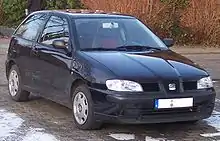
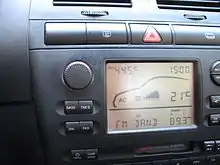

The 1999 Ibiza Mk2 facelift (Typ 6K2, also known as 6K GP01, and sometimes referred to in the UK as the Mk3) was the second Ibiza to be produced under Volkswagen Group management. In the exterior, the facelift of the Ibiza Mk2 introduced apart from the revised front and rear end, new styling cues such as the first-seen tailgate-mounted SEAT badge that doubles also as a boot release switch when pushed swinging open the rear door, while in the interior the changes included a newly designed dashboard along with new door panels. The launch of the Cupra models, along with success in rallying gave it a much stronger, sporty image, which helped align SEAT vis-à-vis the Volkswagen Group's recently acquired budget brand Škoda Auto.
The Ibiza's 1.05, 1.4, 1.6 and 1.8 litre petrol, and 1.9-litre Turbocharged Direct Injection (TDI) and Suction Diesel Injection (SDI) diesel engines were the same as those used in the Volkswagen Polo. The Ibiza's powertrain and running gear was also used in the SEAT Córdoba saloon, estate and coupé.
Under Volkswagen's ownership, SEAT was marketed as a sporty and youthful brand, whose cars were sold at competitive prices. The available trim levels were Entry, S, SE, SX, Award, Stella, Signo, Sport (1.8T 20V 156 PS), Cupra and Cupra R.
SEAT later introduced a more powerful hot hatch, dubbed Cupra, and equipped with a turbocharged 1.8-litre engine, followed by the 1.8-litre turbocharged Cupra R, of which only 200 units were produced. The main difference between the two were suspension, Brembo four-opposed piston front disc brake calipers, and a power upgrade from 156 PS (115 kW; 154 bhp) to 180 PS (132 kW; 178 bhp) on the Cupra R model.
By the time production of the second generation Ibiza/Córdoba ceased during 2002, the range had established itself as one of the most popular superminis in Europe of the past decade, having sold 1,522,607 cars from 1993 to 2002.
Engine specifications
| Model | Displacement | Valves | Max. power / rpm | Max. torque / rpm | Engine code | Top speed | Production period |
|---|---|---|---|---|---|---|---|
| Petrol engines | |||||||
| 1.0 MPI | 999 cc | 8 | 50 PS (37 kW; 49 hp) / 5000 | 86 N⋅m (63 lb⋅ft) / 3000–3600 | ALD / ANV / AUC | 145 km/h (90 mph) | 1999–2002 |
| 1.0 MPI | 999 cc | 16 | 70 PS (51 kW; 69 hp) / 6200 | 91 N⋅m (67 lb⋅ft) / 4500 | AVZ | 165 km/h (103 mph) | 2000–2002 |
| 1.4 MPI | 1,390 cc | 8 | 60 PS (44 kW; 59 hp) / 4700 | 116 N⋅m (86 lb⋅ft) / 3500 | AKK / ANW / AUD | 157 km/h (98 mph) | 1999–2002 |
| 1.4 MPI | 1,390 cc | 16 | 75 PS (55 kW; 74 hp) / 5000 | 128 N⋅m (94 lb⋅ft) / 3300 | APE / AUA | 180 km/h (112 mph) | 1999–2002 |
| 1.6 MPI | 1,598 cc | 8 | 75 PS (55 kW; 74 hp) / 4800 | 135 N⋅m (100 lb⋅ft) / 3200 | ALM | 170 km/h (106 mph) | 1999–2000 |
| 1.6 MPI | 1,595 cc | 8 | 100 PS (74 kW; 99 hp) / 5600 | 145 N⋅m (107 lb⋅ft) / 3800 | AKL / APF / AEH / AUR | 184–188 km/h (114–117 mph) | 1999–2002 |
| 20VT, 1.8T Cupra | 1,781 cc | 20 | 156 PS (115 kW; 154 hp) / 5800 | 210 N⋅m (155 lbf⋅ft) / 1800–5000 | AQX / AYP | 218 km/h (135 mph) | 1999–2002 |
| 1.8T Cupra R | 1,781 cc | 20 | 180 PS (132 kW; 178 hp) / 5600 | 235 N⋅m (173 lb⋅ft) / 2100–5000 | BBU | 225 km/h (140 mph) | 2002–2002 |
| Diesel engines | |||||||
| 1.9 SDI | 1,896 cc | 8 | 68 PS (50 kW; 67 hp) / 4200 | 133 N⋅m (98 lb⋅ft) / 2200–2600 | AGP / AQM | 161 km/h (100 mph) | 1999–2002 |
| 1.9 TDI | 1,896 cc | 8 | 90 PS (66 kW; 89 hp) / 3750 | 210 N⋅m (155 lbf⋅ft) / 1900 | AGR / ALH | 180 km/h (112 mph) | 1999–2002 |
| 1.9 TDI | 1,896 cc | 8 | 110 PS (81 kW; 108 hp) / 4150 | 235 N⋅m (173 lb⋅ft) / 1900 | ASK / ASV | 193 km/h (120 mph) | 1999–2002 |

Motorsport
SEAT was not involved in the World Rally Championship after the 1977 season, until 1995, when, after an 18-year gap, they returned with an Ibiza 1.8 16v driven by Erwin Weber in the Rally of Portugal, in the two wheel drive category. That same year, Erwin Weber won the first place in the two-wheel drive category in the Acropolis Rally, with Antonio Rius in second place. The Copa Ibiza 16V also made its debut that year.[14] The successes of the 1995 season encouraged SEAT to participate the following year in the World Rally Championship in the 2.0-litre engine category, with the SEAT Ibiza Kit Car, a decision which proved to be successful as SEAT won the 1996 FIA 2 Litre World Rally Cup title, becoming the first brand to win the world title in its debut year. SEAT Sport in the next two seasons reaffirmed its domination, winning two consecutive 2-litre WRC championship titles in 1997 and 1998, with drivers Harri Rovanperä, Oriol Gómez, Toni Gardemeister, Jörgen Jonasson and Gwyndaf Evans.
Safety
In 2000, the SEAT Ibiza Mk2 was tested for its safety performance under the Euro NCAP assessment scheme and it achieved a 3 star overall rating:[19]
| Overall rating | |
| Adult occupant | |
| Pedestrian |

Rebadges
The Ibiza was also produced in South Africa where it was rebadged as the Volkswagen Polo Playa.
Third generation (Typ 6L; 2002–2008)
| SEAT Ibiza Mk3 (6L) | |
|---|---|
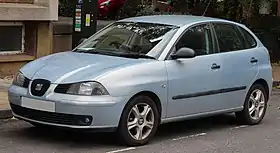 SEAT Ibiza Mk3 pre-facelift, front view | |
| Overview | |
| Production | 2002–2008 |
| Assembly |
|
| Designer | Walter de'Silva |
| Body and chassis | |
| Body style | 3 and 5-door hatchback |
| Platform | Volkswagen Group A04 (PQ24) |
| Related | SEAT Córdoba Mk2 Volkswagen Polo Mk4 Škoda Fabia Mk1 Škoda Fabia Mk2 |
| Powertrain | |
| Engine | Petrol engines: 1.2 L I3 1.4 L I4 1.6 L I4 1.8 L I4 20v Turbo 2.0 L I4 Diesel engines: 1.4 L I3 TDI 1.9 L I4 SDI 1.9 L I4 TDI |



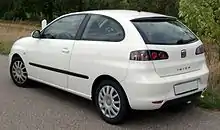


The Ibiza Mk3 (Typ 6L) was the second Ibiza generation model to be fully produced under Volkswagen Group ownership. Built on the same PQ24 platform as the Volkswagen Polo Mk4 (Typ 9N), it is styled by the Italian designer Walter de Silva, intended to have a sporty, performance image. The model line up includes two hot hatch variants, the Ibiza FR and Cupra, which compensate for the lack of Polo hot hatch variants (the Polo GTI wasn't launched until 2006).
Its production was initially focused in SEAT's main plant in Martorell, Spain, however in September 2002 a decision was taken by the Volkswagen Group, i.e. SEAT's parent company, that a part of it (up to 50,000 units annually) would be transferred to Volkswagen's own plant in Bratislava, Slovakia.
Apart from the more aggressive styling, it was larger than the previous two generations, with room for five adults, and a spacious (if rather short) boot. The standard trim level on this model is noticeably higher than previous models. This is regarded by some magazines to be the best supermini, with What Car? magazine calling it "Car of the Year" in 2003, and their best "Supermini of the Year" for three years in a row.[22]
The SEAT Ibiza Mk3 has also been used for several purposes, from police cars to rally cars
The Ibiza Mk3 pre-facelift model was available with the Award, S, SX, Stylance, Reference, Signo, Stella, Sport, FR and Cupra R trim levels.
The facelifted third generation Ibiza was made from 2006 to 2008. In 2006, slight cosmetic changes were made to both the interior and exterior, but is otherwise the model is very similar to the original one. There were also introduced new trim levels (Reference, Stylance, Freerider, Sportrider, Sport, DAB Sport (2006 limited edition), Formula Sport (2007 limited edition), FR and Cupra, as well as engines with increased power (1.2 12v and 1.4 16v) and a new 1.4 litre Turbocharged Direct Injection (TDI) diesel version. The FR and Cupra R TDI versions use a 1.9-litre Pumpe-Düse diesel engine with 130 PS (96 kW; 128 bhp) and 160 PS (118 kW; 158 bhp) respectively.The top petrol versions use a 1.8-litre 20v turbo engine with 150 PS (110 kW; 148 bhp) for the FR model and 180 PS (132 kW; 178 bhp) for the Cupra R model .The Ibiza Cupra R TDI and Cupra R 1.8T versions are the top models of the brand,hot hatches made to compete with the rivals in the fwd hot hatch segment.There are also 2 special editions of the Ibiza Cupra R.The first one is called Nürburgring Edition(2006-2007) distinguishing with black painted side mirrors and Nürburgring inscription on the door panels.The second one is the Last Edition(2008 only) distinguishing with new interior logo on the front seats and the gear knob.
Engine specifications
| Model | Displacement | Configuration | Valves | Max. power at rpm | Max. torque at rpm | Engine code | Top speed | Production period |
|---|---|---|---|---|---|---|---|---|
| Petrol engines | ||||||||
| 1.2 | 1,198 cc | Inline-3 OHC | 6 | 54 PS (40 kW; 53 hp) / 4750 | 106 N⋅m (78 lb⋅ft) / 3000 | AWY / BMD | 155 km/h (96 mph) | 2002–2007 |
| 1.2 | 1,198 cc | Inline-3 OHC | 6 | 60 PS (44 kW; 59 hp) / 5200 | 108 N⋅m (80 lb⋅ft) / 3000 | BBM | 159 km/h (99 mph) | 2007–2008 |
| 1.2 | 1,198 cc | Inline-3 DOHC | 12 | 64 PS (47 kW; 63 hp) / 5400 | 112 N⋅m (83 lb⋅ft) / 3000 | AZQ / BME | 166 km/h (103 mph) | 2002–2005 |
| 1.2 | 1,198 cc | Inline-3 DOHC | 12 | 70 PS (51 kW; 69 hp) / 5400 | 112 N⋅m (83 lb⋅ft) / 3000 | BZG | 170 km/h (106 mph) | 2006–2008 |
| 1.4 | 1,390 cc | Inline-4 DOHC | 16 | 75 PS (55 kW; 74 hp) / 5000 | 126 N⋅m (93 lb⋅ft) / 3800 | AUA / BBY / BKY | 169–173 km/h (105–107 mph) | 2002–2006 |
| 1.4 | 1,390 cc | Inline-4 DOHC | 16 | 86 PS (63 kW; 85 hp) / 5000 | 132 N⋅m (97 lb⋅ft) / 3800 | BXW | 180 km/h (112 mph) | 2006–2008 |
| 1.4 | 1,390 cc | Inline-4 DOHC | 16 | 101 PS (74 kW; 100 hp) / 6000 | 126 N⋅m (93 lb⋅ft) / 4400 | AUB / BBZ | 190 km/h (118 mph) | 2007–2008 |
| 1.6 | 1,598 cc | Inline-4 OHC | 8 | 101 PS (74 kW; 100 hp) / 5500 | 140 N⋅m (103 lbf⋅ft) / 3250 | BAH | 187 km/h (116 mph) | 2002–2009 |
| 1.6 | 1,598 cc | Inline-4 DOHC | 16 | 105 PS (77 kW; 104 hp) / 5600 | 153 N⋅m (113 lb⋅ft) / 3800 | BTS | 193 km/h (120 mph) | 2006–2008 |
| 1.8T FR | 1,781 cc | Inline-4 DOHC | 20 | 150 PS (110 kW; 148 hp) / 5800 | 220 N⋅m (162 lbf⋅ft) / 1950 | BJX | 216 km/h (134 mph) | 2004–2008 |
| 1.8T Cupra R | 1,781 cc | Inline-4 DOHC | 20 | 180 PS (132 kW; 178 hp) / 5800 | 245 N⋅m (181 lb⋅ft) / 2000 | BBU | 230 km/h (143 mph) | 2004–2008 |
| 2.0 | 1,984 cc | Inline-4 OHC | 8 | 115 PS (85 kW; 113 hp) / 5200 | 170 N⋅m (125 lbf⋅ft) / 2400 | AZL / BBX | 200 km/h (124 mph) | 2003–2004 (until 2009 for Latin-America) |
| Diesel engines | ||||||||
| 1.4 TDI | 1,422 cc | Inline-3 OHC | 6 | 70 PS (51 kW; 69 hp) / 4000 | 155 N⋅m (114 lb⋅ft) / 1600–2800 | BNM | 166 km/h (103 mph) | 2005–2008 |
| 1.4 TDI | 1,422 cc | Inline-3 OHC | 6 | 75 PS (55 kW; 74 hp) / 4000 | 195 N⋅m (144 lb⋅ft) / 2200 | AMF / BAY | 180 km/h (112 mph) | 2003–2005 |
| 1.4 TDI | 1,422 cc | Inline-3 OHC | 6 | 80 PS (59 kW; 79 hp) / 4000 | 195 N⋅m (144 lb⋅ft) / 2200 | BNV / BMS | 176 km/h (109 mph) | 2005–2007 |
| 1.9 SDI | 1,896 cc | Inline-4 OHC | 8 | 64 PS (47 kW; 63 hp) / 4000 | 125 N⋅m (92 lb⋅ft) / 1600–2800 | ASY | 162 km/h (101 mph) | 2002–2006 |
| 1.9 TDI | 1,896 cc | Inline-4 OHC | 8 | 101 PS (74 kW; 100 hp) / 4000 | 240 N⋅m (177 lbf⋅ft) / 1800–2400 | ATD / AXR / BMT | 190 km/h (118 mph) | 2002–2008 |
| 1.9 TDI Sport/FR | 1,896 cc | Inline-4 OHC | 8 | 130 PS (96 kW; 128 hp) / 4000 | 310 N⋅m (229 lbf⋅ft) / 1900 | ASZ / BLT | 206 km/h (128 mph) (Sport) 208 km/h (129 mph) (FR) | 2002–2003 (Sport) 2004–2008 (FR) |
| 1.9 TDI Cupra R | 1,896 cc | Inline-4 OHC | 8 | 160 PS (118 kW; 158 hp) / 3750 | 330 N⋅m (243 lbf⋅ft) / 1900 | BPX / BUK | 220 km/h (137 mph) | 2004–2008 |
Safety
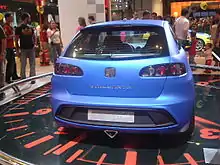
In 2002, the SEAT Ibiza Mk3 was tested for its safety performance under the Euro NCAP assessment scheme and it achieved a 4 star overall rating:[23]
| Overall rating | |
| Adult occupant | |
| Pedestrian |
Awards
Concept cars
In the 2006 Geneva Motorshow SEAT presented the SEAT Ibiza Vaillante concept car which was based on a 3-door SEAT Ibiza Mk3 car.
Fourth generation (6J/6P; 2008-2017)
| SEAT Ibiza Mk4 (6J) | |
|---|---|
_%E2%80%93_Frontansicht%252C_25._April_2011%252C_Ratingen.jpg.webp) | |
| Overview | |
| Production | 2008–2017 |
| Assembly | |
| Designer | Luc Donckerwolke |
| Body and chassis | |
| Body style | 3 and 5-door hatchback 5-door estate |
| Platform | Volkswagen Group A05 (PQ25) |
| Related | Volkswagen Polo Mk5 Audi A1 Škoda Fabia Mk3 |
| Powertrain | |
| Engine | 1.0 L I3 1.0 L I3 T SI 1.2 L I3 1.2 L I4 T SI 1.4 L I4 1.4 L I4 T SI 1.6 L I4 1.8 L I4 T SI 2.0 L I4 (Mexico) 1.2 L I3 TDI 1.6 L I4 TDI |
| Transmission | 5-speed manual 6-speed manual 7-speed DSG automatic |
| Dimensions | |
| Wheelbase | 2,469 mm (97.2 in) |
| Length | 4,031–4,072 mm (158.7–160.3 in) (3-door) 4,052 mm (159.5 in) (5-door) 4,227 mm (166.4 in) (estate) |
| Width | 1,693 mm (66.7 in) |
| Height | 1,420–1,428 mm (55.9–56.2 in) (3-door) 1,445 mm (56.9 in) (5-door, estate) |
| Kerb weight | 974–1,172 kg (2,147–2,584 lb) (3-door) 999–1,120 kg (2,202–2,469 lb) (5-door) |

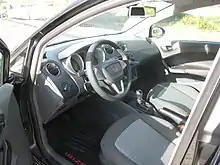
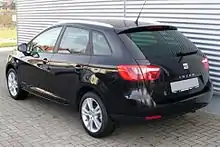
The Ibiza Mk4 (Typ 6J) was previewed at the 2008 Geneva Motor Show in the form of the Bocanegra concept car.[26] It was styled by the Belgian car designer Luc Donckerwolke with the distinctive 'arrow design', dispensing with the basic Ibiza design language that had been in place since the 1984 original, and being the first among other Volkswagen Group models (Volkswagen Polo Mk5 and Audi A1) to use the latest Volkswagen Group PQ25 platform in the segment of supermini cars,[27][28][29][30]
The model range features a 5-door hatchback, a 3-door version and a 5-door estate, the latter was added in Q4 2010.
The new model first went on sale in the summer of 2008, in the 5 door format,[31] followed by a 3-door variant, marketed as the Ibiza SportCoupé or Ibiza SC. An Ibiza Ecomotive model, powered by an 80 PS (59 kW; 79 bhp), 1.4-litre diesel engine emitting 98 g/km of CO
2, was launched late in 2008.[32]
High-performance Ibiza FR, Cupra and Bocanegra models were launched in June 2009.[33] The Ibiza FR is powered by a 150 PS (110 kW; 148 bhp) 1.4 TSI twincharger (turbo and supercharger) engine with a seven-speed Direct-Shift Gearbox (DSG),[34] while the Ibiza Cupra and Bocanegra have the same powertrain tuned to 180 PS (132 kW; 178 bhp).[35]
In January 2010, SEAT introduced first in the Volkswagen Group on the Ibiza's specific platform the 2.0 TDI Diesel engine in both SportCoupe and five-door Ibiza FR specification. The 2.0 TDI boasts 143 PS (105 kW; 141 bhp) and an average consumption of 4.6 L/100 km (61 mpg‑imp; 51 mpg‑US).[36][37]
In September 2010, the Ibiza's SportCoupe and 5 door range was extended with the further addition of the new 1.2 TSI 105 PS (77 kW; 104 bhp) engine.[38]
A special version of the Ibiza Mk4, called "25th anniversary", was presented at the Barcelona Motor Show in 2009, to celebrate the 25th anniversary of SEAT's best seller Ibiza.[39]
There are many different trim levels for the Ibiza Mk4.[40] From 2009 onwards, the SEAT Ibiza was used exclusively by the UK-based Young Driver Scheme. The Young Driver Scheme uses a mixture of the SportsCoupe and 5 door variants, powered by the 1.2 engine.[41]
In July 2010, a revised Ibiza Ecomotive was announced, powered by 75 PS (55 kW; 74 bhp) 1.2 TDI common rail diesel engine with CO
2 emissions of 89 g/km.[42]
Facelift
_%E2%80%93_Frontansicht%252C_31._M%C3%A4rz_2012%252C_D%C3%BCsseldorf.jpg.webp)
_%E2%80%93_Heckansicht%252C_7._September_2013%252C_M%C3%BCnster.jpg.webp)
The facelift model was launched at the 2012 Geneva Motor Show, and sales began shortly thereafter. The facelift consisted of a light exterior and interior refresh.
Ibiza ST
A 5-door estate car variant, the Ibiza ST, was announced in March 2010, at the Geneva Motor Show.[43]
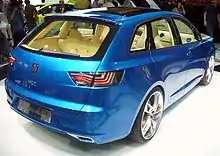
The preview of the Ibiza ST was shown at the 2009 Frankfurt Motor Show in the form of the IBZ concept car.[44]
The Ibiza ST is 4.23 m (167 in) long, which increases the boot volume to 430 litres. Two new engine options were introduced with this model, a 105 PS 1.2 TSI (petrol) and a 75 PS 1.2 TDI diesel.[45]
Ibiza CONNECT
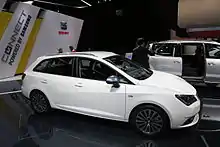
The CONNECT model was presented at the 2015 Frankfurt Motor Show[46] and is equipped with Full Link connectivity technology, the Samsung Galaxy A3 and the SEAT ConnectApp. This allows the user’s smartphone to be connected to the car’s infotainment system and use connectivity features. The SEAT Ibiza CONNECT has a range of exterior body colours that allow the mirrors and wheels to be customised.
Engine specifications
| Model | Displacement | Configuration | Valves | Max. power at rpm | Max. torque at rpm | Engine code | Production period |
|---|---|---|---|---|---|---|---|
| Petrol engines | |||||||
| 1.2 | 1,198 cc | Inline-3 OHC | 6 | 60 PS (44 kW; 59 hp) / 5200 | 108 N⋅m (80 lb⋅ft) / 3000 | BKV | 5/2009– |
| 1.2 | 1,198 cc | Inline-3 DOHC | 12 | 70 PS (51 kW; 69 hp) / 5400 | 112 N⋅m (83 lb⋅ft) / 3000 | BZG / CGPA | 4/2008– |
| 1.2 TSI (*) | 1,197 cc | Inline-4 OHC | 8 | 105 PS (77 kW; 104 hp) / 5000 | 175 N⋅m (129 lb⋅ft) / 1550−4100 | CBZB | 3/2010– |
| 1.2 TSI | 1,197 cc | Inline-4 DOHC | 16 | 90 PS (66 kW; 89 hp) / 4400-5400 | 160 N⋅m (118 lbf⋅ft) / 1400-3500 | CJZC | 2015- |
| 1.4 (*) | 1,390 cc | Inline-4 DOHC | 16 | 86 PS (63 kW; 85 hp) / 5000 | 132 N⋅m (97 lb⋅ft) / 3800 | BXW / CGG | 4/2008– |
| 1.4 TSI FR ACT | 1,395 cc | Inline-4 DOHC | 16 | 140 PS (103 kW; 138 hp) / 4500-6000 | 250 N⋅m (184 lbf⋅ft) / 1500−3500 | CAVF | 5/2009– |
| 1.4 TSI FR | 1,390 cc | Inline-4 DOHC | 16 | 150 PS (110 kW; 148 hp) / 5800 | 220 N⋅m (162 lbf⋅ft) / 1250−4500 | CAVF | 5/2009– |
| 1.4 TSI Cupra | 1,390 cc | Inline-4 DOHC | 16 | 180 PS (132 kW; 178 hp) / 6200 | 250 N⋅m (184 lbf⋅ft) / 2000−4500 | CAVE/CTHE | 5/2009–11/2015 |
| 1.8 TSI Cupra | 1,798 cc | Inline-4 DOHC | 16 | 192 PS (141 kW; 189 hp) / 6200 | 320 N⋅m (236 lbf⋅ft) / 1450-4200 | DAJA | 11/2015– |
| 1.6 | 1,598 cc | Inline-4 DOHC | 16 | 105 PS (77 kW; 104 hp) / 5600 | 153 N⋅m (113 lb⋅ft) / 3800 | BTS | 4/2008–04/2010 |
| 1.6 LPG Bifuel | 1,598 cc | Inline-4 DOHC | 16 | 81 PS (60 kW; 80 hp)/ 4000−6000 | 145 N⋅m (107 lb⋅ft) / 3800 | CNKA | 05/2011 – |
| 2.0 (Mexico) | 1,984 cc | Inline-4 OHC | 8 | 115 PS (85 kW; 113 hp) / 5200 | 170 N⋅m (125 lbf⋅ft) / 2400 | CEKA | |
| Diesel engines | |||||||
| 1.2 TDI CR DPF (*) | 1,199 cc | Inline-3 DOHC | 12 | 75 PS (55 kW; 74 hp) / 4200 | 180 N⋅m (133 lbf⋅ft) / 1500–3450 | CFWA | 5/2010– |
| 1.4 TDI PD DPF | 1,422 cc | Inline-3 OHC | 6 | 80 PS (59 kW; 79 hp) / 4000 | 195 N⋅m (144 lb⋅ft) / 2200 | BMS | 4/2008–4/2010 |
| 1.6 TDI CR DPF (*) | 1,598 cc | Inline-4 DOHC | 16 | 90 PS (66 kW; 89 hp) / 4200 | 230 N⋅m (170 lbf⋅ft) / 1500–2500 | CAYB | 5/2009–12/2015 |
| 1.6 TDI CR DPF (*) | 1,598 cc | Inline-4 DOHC | 16 | 105 PS (77 kW; 104 hp) / 4400 | 250 N⋅m (184 lbf⋅ft) / 1500–2500 | CAYC | 10/2009–12/2015 |
| 1.9 TDI PD DPF | 1,896 cc | Inline-4 OHC | 8 | 90 PS (66 kW; 89 hp) / 4000 | 210 N⋅m (155 lbf⋅ft) / 1800–2500 | BXJ | 4/2008–5/2009 |
| 1.9 TDI PD DPF | 1,896 cc | Inline-4 OHC | 8 | 105 PS (77 kW; 104 hp) / 4000 | 240 N⋅m (177 lbf⋅ft) / 1900 | BLS | 4/2008–5/2009 |
| 2.0 TDI FR CR DPF | 1,968 cc | Inline-4 DOHC | 16 | 143 PS (105 kW; 141 hp) / 4200 | 320 N⋅m (236 lbf⋅ft) / 1750–2500 | CFHD | 10/2009–12/2015 |
Note: (*) Also fitted on the Ibiza ST
Safety
In 2008, the SEAT Ibiza Mk4 was tested for its safety performance under the Euro NCAP assessment scheme and it achieved a 5 star overall rating:[47]
| Overall rating | |
| Adult occupant | |
| Child occupant | |
| Pedestrian |
Second facelift

The Ibiza received a second, more thorough facelift in 2015. The interior as well as the exterior have been changed. According to SEAT, the interior raw materials used are higher in quality and the overall design is more driver focused and ergonomic. With the steering wheel, gear stick, air vents, radio buttons and door handles it’s possible to personalise with a range of available colours. The centre console is more accessible and there are multiple new technology additions. It is equipped with a multifunctional steering wheel, ambient lighting and an integrated navigation system along with Full Link technology. The Full Link technology allows connectivity with the driver’s mobile phone in a safe and easy way. Mirror Link technology, through the second generation MIB infotainment system, also replicates the smartphone screen when a compatible device is plugged in. Full Link is also compatible with both Android and Apple smartphones.
The safety features included are: day running full LED lights, parking assist with audio warnings and a rear-view camera which provides live video from the rear of the car to make the driver aware of obstacles when reversing.
Externally, the biggest difference is full LED lights. It will be available as a 5-door, sport coupé, and sport tourer, as with the previous Ibiza. A range of Volkswagen Group's new 1.0-litre three-cylinder engines (MPI and TSI) are perhaps the biggest news for the facelifted Ibiza.
Fifth generation (6F; 2017)
| SEAT Ibiza Mk5 | |
|---|---|
 | |
| Overview | |
| Production | 2017-present |
| Assembly | |
| Body and chassis | |
| Body style | 5-door hatchback |
| Platform | Volkswagen Group MQB A0 |
| Related | SEAT Arona |
| Powertrain | |
| Engine | 1.0 L I3 MPI (Multi Point Injection) 1.0 L I3 TSI 1.5 L I4 TSI 1.6 L I4 TDI |
| Transmission | 5-speed manual 6-speed manual 7-speed DSG automatic |
| Dimensions | |
| Wheelbase | 2,564 mm (100.9 in) |
| Length | 4,059 mm (159.8 in) (5-door) |
| Width | 1,780 mm (70.1 in) |
| Height | 1,444 mm (56.9 in) (5-door) |

_interior.jpg.webp)
The fifth generation SEAT Ibiza 5-door hatchback was introduced at the 2017 Geneva Motor Show. It is based on the MQB A0 platform.[49] It is 2 mm shorter and 87 mm wider than the preceding generation. It was the first vehicle in the VAG group to use the MQB-A0 platform, before the VW Polo, Skoda Fabia and the Audi A1. Engine options include the 1.0 MPi, 1.0 TSi 3-cylinder petrol, 1.5 TSi EVO and the 1.6 TDi four-cylinder diesel.
The new Ibiza shares its styling with its larger sister car in the SEAT range, the León.
Motorsport

- Rallycross
The SEAT Ibiza is currently used by German team Münnich Motorsport in the FIA World Rallycross Championship. Debuting at the 2016 World RX of Portugal, the vehicle has had a best result of fifth in the French round of the 2016 season.
Reliability
Reliability has been mixed. Auto Bild endurance tests from 2011 showed the Ibiza had achieved not only the "best result of any car in the VW Group" but also the "best result for a small car in the history of the AutoBild 100,000 km endurance tests".[50] Warranty Direct list the Ibiza name among the UK's 100 most reliable cars[51] despite recent generations scoring poorly[52] and SEAT being ranked 26th of 40 manufacturers overall.[53]
Sales and production figures
Since the first generation of the SEAT Ibiza launched in 1984, more than 4 million SEAT Ibiza cars have been sold in its four generations as of 2011.[2]
| Model year | Ibiza Mk1 | Ibiza Mk2 | Ibiza Mk3 |
|---|---|---|---|
| Years | 1984–1993 | 1993–2002 | 2002–2007 |
| Total sales[2] | 1,342,001 | 1,522,607 | 1,084,989 |
In the year 2009, the total annual retail sales number of SEAT Ibiza cars was 170,833 vehicles,[54] while the annual production of SEAT Ibiza vehicles made in SEAT's Martorell plant came up to 173,715 units.
The total production per year of SEAT Ibiza cars, manufactured in SEAT and other Volkswagen group's plants, is shown in the following table:
| Model | 1986[55] | 1987[56] | 1988[57] | 1989[57] | 1990[58] | 1991[59] | 1992[60] | 1993[61] | 1994[62] | 1995[63] | 1996[64] | 1997[65] | 1998[66] | 1999[66] | 2000[66] | 2001[67] | 2002[68] |
|---|---|---|---|---|---|---|---|---|---|---|---|---|---|---|---|---|---|
| Total annual production | 121,526 | 160,907 | 192,024 | 208,210 | 202,157 | 173,236 | 112,334 | 142,987 | 140,974 | 158,284 | 153,000 | 168,492 | 180,775 | 194,245 | 199,279 | 188,427 | 197,311 |
| Model year | 2003[69] | 2004[70] | 2005[71] | 2006[72] | 2007[73] | 2008[74] | 2009[75] | 2010[76] | 2011[77] | 2012 [78][79] |
2013 [80][81] |
2014 [82][83] |
2015 [84][85] |
2016[86] | 2017[87] | 2018[88] | 2019[89] |
| Total annual production | 220,497 | 183,754 | 168,645 | 183,848 | 172,206 | 192,470 | 173,715 | 189,083 | 191,183 | 160,887 | 145,041 | 153,633 | 160,451 | 149,988 | 160,377 | 120,287 | 130,243 |
See also
References
- "New SEAT Ibiza". SEAT. Retrieved 19 February 2017.
- "A success story spanning 25 years". SEAT media center. 5 July 2009. Archived from the original on 19 July 2011.
- "Company history, 1989-1980". SEAT. Archived from the original on 29 October 2012.
- "Ibiza" (in Italian). Italdesign Giugiaro. Retrieved 8 March 2010.
- "SEAT cumple 60 años" (in Spanish). SEAT media center. 30 April 2010. p. 9.
- "Historia de la SEAT Ibiza: la primera generación (1984-1993)". Cool-fast-cars.com. Archived from the original on 8 July 2011. Retrieved 8 March 2010.
- Mastrostefano, Raffaele, ed. (1990). Quattroruote: Tutte le Auto del Mondo 1990 (in Italian). Milano: Editoriale Domus S.p.A. p. 902.
- Sanfront, Emanuele (January 1989). "Qualche tocco ed è seconda serie" [A few touches makes a second series]. Quattroruote (in Italian). Vol. 34 no. 399. Milan, Italy: Editoriale Domus. p. 122.
- Sanfront, p. 123
- Auto Katalog 1993. Stuttgart: Vereinigte Motor-Verlage GmbH & Co. KG. 1992. pp. 44–45, Technische Daten tearout.
- "Seat Ibiza specifications". Auto-types.com. Retrieved 9 November 2012.
- "Carburettor Kit - Meat and Doria". m.meat-doria.com.
- studio, support@vepump.com,chenzhong. "diesel fuel injectiom pump". www.vepump.com.
- "Compañía, SEAT en competición". SEAT Sport.
Las primeras actividades fueron crear la Copa VW Polo de circuitos y el Campeonato SEAT Ibiza de Rallies. [...] Debutó la Copa Ibiza 16v.
- "SEAT IBIZA BIMOTOR 1986". BAJA ESPAÑA ARAGON.
- World of Cars 2006·2007. Warsaw, Poland: Media Connection Sp. z o.o. 2006. p. 236.
- David Villarreal, David. "Anibal Podadera, el Seat Ibiza Raider coupé de 1986". Diariomotor website. Diariomotor. Retrieved 10 February 2013.
- "Recorrido por la NAVE A122 Parte". SEAT FANSCLUB. 30 December 2011.
- "SEAT Ibiza Mk2". Euro NCAP. Retrieved 4 November 2011.
- "SEAT, S.A. Key Figures (2005 / 2009)". SEAT media center. 24 March 2010. Archived from the original on 7 January 2012.
The SEAT Ibiza is chosen "Car of the Year" in Spain and Portugal.
- "Desportivo do ano" [Sports car of the year]. SEAT Portugal. Archived from the original on 4 January 2011.
- "Used Seat Ibiza Hatchback Car Review". What Car?. Retrieved 8 March 2010.
- "SEAT Ibiza Mk3". Euro NCAP. Retrieved 4 January 2011.
- "Galardones para el nuevo León, Altea e Ibiza". SEAT media center. 2 December 2005. Archived from the original on 19 July 2011.
- "L'usine Volkswagen en Algérie assemblera la Golf, Ibiza, Octavia et Caddy dès juin prochain - Actualité Auto". www.autobip.com.
- Powell, Will (3 March 2008). "Updated: Seat Bocanegra". Autocar magazine. Archived from the original on 1 May 2008.
- "Seat boss: New Ibiza matches Toyota quality". Automotive News Europe. 12 May 2008.
The Ibiza is the first small model to use VW group’s PQ25 architecture
- "Next-generation VW small-car platform to offer all-wheel drive". LeftLaneNews. 6 May 2008.
- "Volkswagen Polo and Audi A1 will share new AWD platform". Top Speed. 5 June 2008.
- "2008 Paris Motor show photos & coverage". Motor Trend Magazine.
- Jörn Thomas u. Achim Hartmann (Bilder) (2008). Auto Motor und Sport Heft 11 Seite 52. Stuttgart. German availability of the four (five) door hatch began 14 June 2008, with two (three with the hatch) door versions appearing in late summer.
- Aucock, Richard (5 December 2008). "Seat Ibiza Ecomotive (2009) CAR review". CAR Magazine. Retrieved 4 May 2009.
- "The Ibiza range grows with the new FR, CUPRA and Bocanegra models and the 1.6 TDI CR engine". SEAT media center. 30 June 2009. Retrieved 13 July 2009.
- "The Ibiza FR and the León CUPRA boost the sporty range". SEAT media center. 16 April 2009. Retrieved 4 May 2009.
- "The Ibiza range grows with addition of the CUPRA and ECOMOTIVE". SEAT media center. 12 September 2008. Retrieved 4 May 2009.
- "The new 143 hp SEAT Ibiza FR 2.0 TDI CR". SEAT media center. Retrieved 20 October 2010.
- "Seat adds diesel Ibiza FR". Autocar.co.uk. 20 January 2010. Retrieved 8 March 2010.
- "El motor 1.2 TSI llegará a SEAT en breve". Autoblog. 22 January 2010.
- "SEAT celebrates the 25th anniversary of the Ibiza with a special version". Media.seat.com. 29 April 2009. Retrieved 8 March 2010.
- "MK5 (2008 – present)". Ibiza Owners Club.
- "Young Driver Hire - Young Driver Cars - Car Hire For Young Drivers". Young Driver Training. Retrieved 17 February 2011.
- "New Ibiza ECOMOTIVE – the lowest emissions of its segment". SEAT media center. 19 July 2010. Retrieved 10 September 2010.
- "SEAT Ibiza ST – compact dynamics with great usability". SEAT media center. 1 March 2010. Retrieved 10 March 2010.
- "Frankfurt motor show: Seat Ibz concept". Autocar. 15 September 2009. Retrieved 17 October 2009.
- "Seat Ibiza Mk4 Brochure" (PDF) (in French). Seat Belgium. 12 April 2012. Archived from the original (PDF) on 3 August 2012.
- http://www.seat-mediacenter.es/en-stories/motorshows/seat-cars-connect-with-the-future/%5B%5D
- "SEAT Ibiza Mk4". Euro NCAP. Retrieved 20 October 2010.
- https://www.autobip.com/nouvelle-seat-ibiza-dz-tarifs-et-finitions-ouverture-des-commandes-ce-jeudi-mise-%C3%A0-jour-actualite-auto-algerie-d5164 Missing or empty
|title=(help) - "New SEAT Ibiza 2017 review".
- "AutoBild".
SEAT Ibiza: bester Kleinwagen in der langen Geschichte der AUTO BILD-Dauertests und bestes Produkt des VW-Konzerns.
- "Top 100 UK Cars". Warranty Direct.
- "Seat Ibiza 08- Reliability". Warranty Direct.
- "Manufacturer Rankings". Warranty Direct. 2019.
- "SEAT Annual report 2009". SEAT media center. Archived from the original on 27 March 2010.
- "Volkswagen AG Annual Report 1986" (PDF). Retrieved 6 July 2019.
- "Volkswagen AG Annual Report 1987" (PDF). Retrieved 6 July 2019.
- "Volkswagen AG Annual Report 1989" (PDF). Retrieved 6 July 2019.
- "Volkswagan AG Annual Report 1990" (PDF). Retrieved 6 July 2019.
- "Volkswagan AG Annual Report 1991" (PDF). Retrieved 6 July 2019.
- "Volkswagen AG Annual Report 1992" (PDF). Retrieved 6 July 2019.
- "Volkswagen AG Annual Report 1993" (PDF). Retrieved 6 July 2019.
- "Volkswahen AG Annual Report 1994" (PDF). Retrieved 6 July 2019.
- "Volkswagen AG Annual Report 1995" (PDF). Retrieved 6 July 2019.
- "Volkswagen AG Annual Report 1996" (PDF). Retrieved 6 July 2019.
- "Volkswagen AG Annual Report 1997" (PDF). Retrieved 6 July 2019.
- "Volkswagen AG Annual Report 1999" (PDF). Volkswagen AG. 13 September 2010. Retrieved 13 September 2010.
- "Volkswagen AG Annual Report 2000" (PDF). Retrieved 6 February 2012.
- "Volkswagen AG Annual Report 2001" (PDF). Retrieved 6 February 2012.
- "Volkswagen AG Annual Report 2002" (PDF). Retrieved 6 February 2012.
- "Volkswagen AG Annual Report 2003" (PDF). Retrieved 6 February 2012.
- "Volkswagen AG Annual Report 2004" (PDF). Retrieved 6 February 2012.
- "Volkswagen AG Annual Report 2005" (PDF). Retrieved 5 February 2012.
- "Volkswagen AG Annual Report 2006" (PDF). Retrieved 5 February 2012.
- "Volkswagen AG Annual Report 2007" (PDF). Retrieved 5 February 2012.
- "Volkswagen AG Annual Report 2008" (PDF). Retrieved 5 February 2012.
- "Volkswagen AG Annual Report 2010" (PDF). Retrieved 5 February 2012.
- "Seat mejora sus ventas mundiales un 3,1% en 2011". Elpais.com. Retrieved 5 February 2012.
- "Skoda Annual Report 2012" (PDF). Retrieved 29 June 2019.
- "Volkswagen AG Annual Report 2012" (PDF). Retrieved 28 June 2019.
- "Skoda Annual Report 2013" (PDF). Retrieved 29 June 2019.
- "Volkswagen AG Annual Report 2013" (PDF). Retrieved 28 June 2019.
- "Skoda Annual Report 2015" (PDF). Retrieved 29 June 2019.
- "Volkswagen AG Annual Report 2014" (PDF). Retrieved 28 June 2019.
- "Volkswagen AG Annual Report 2015" (PDF). Retrieved 28 June 2019.
- "Skoda Annual Report 2015" (PDF). Retrieved 29 June 2019.
- "Volkswagen AG Annual Report 2016" (PDF). Retrieved 28 June 2019.
- "Volkswagen AG Annual Report 2017" (PDF). Retrieved 28 June 2019.
- "Volkswagen AG Annual Report 2018" (PDF). Retrieved 28 June 2019.
- "Volkswagen AG Annual Report 2019" (PDF). Retrieved 17 March 2020.
External links
| Wikimedia Commons has media related to SEAT Ibiza. |
- SEAT Ibiza SC – SEAT UK website
- SEAT Ibiza 5dr – SEAT UK website
- SEAT Ibiza ST – SEAT UK website
